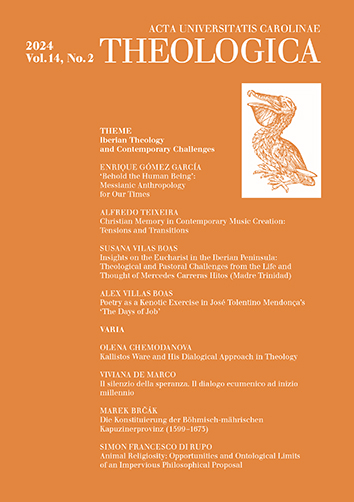AUC Theologica is a peer-reviewed journal for theology published twice a year. As we publish original papers in English, German, French, and Italian, our mission is to serve as a platform both for Czech researchers, who can present their research results in these languages, and for international contributors, who are invited to enter the academic theological discussion in the heart of Europe.
The journal focuses on a wide range of theological disciplines, such as systematic theology, biblical studies, patristic studies, pastoral and spiritual theology, religious education, church history, etc. Within these fields, the journal seeks to reflect the current theological questions and problems, which often requires interdisciplinary approaches. Supporting the intersection of various theological disciplines, we thus also welcome theological papers touching other academic fields including philosophy, sociology, literary studies, and science.
Each issue consists of two sections. The thematic section presents papers of the same focus. The section called ‘Varia’ invites papers dealing with various theological themes from the perspective of all Christian traditions. Our current and past issues are approachable for free on this website in the form of Open Access.
AUC THEOLOGICA, Vol 2 No 1 (2012), 9–28
Velikonoční tajemství v liturgických textech arabofonní koptské církve
[The Easter mystery in liturgical texts of the arabophone Coptic Church]
Mlada Mikulicová
DOI: https://doi.org/10.14712/23363398.2015.45
published online: 26. 06. 2020
abstract
Coptic-Arabic liturgical texts express the Easter mysteries in the rich idiom of the Scriptures and ancient Christian tradition, as seen in the Eucharistic Liturgies of St. Basil and St. Gregory, as well as in hymns and prayers of the Sixth and the Ninth Canonical Hours. They concentrate on the sacrifice of Christ on the cross as connected to that of the Holy Mass. The liturgical texts profess, in accordance to the Creed, the Divine economy of salvation in the incarnation of the Son of God and his crucifixion for human sin, his death and descent to the hell as well as ascent to the Father. Prefigured in Isaac and the Suffering Servant, he is seen as establishing the Eucharistic Sacrament on Maundy Thursday to perpetualize the effects of his sacrifice for participants in the Mass. His trial and his suffering before Pontius Pilate is contemplated, along with his crucifixion, his acceptance of the Thief on the Right. The liturgical texts essentially confess Christ’s death in the human body, his burial and descent to save the deceased, his resurrection and his ascension to sit with the Father. These points are succintly expressed in the ancient Trisagion. Fundamental is the connection between Christ’s incarnation and the redemption as well as between his past work of salvation and its present effect in the Eucharist. Coptic liturgical texts unite catechesis of faith to acting out Christ’s Easter mysteries where the salvatory events happen in the life of the participants.
keywords: Coptic-Arabic liturgical texts; Euchologion; Canonical Hours; St. Basil Liturgy; Easter mystery; incarnation; redemption; Eucharist

Velikonoční tajemství v liturgických textech arabofonní koptské církve is licensed under a Creative Commons Attribution 4.0 International License.
148 x 210 mm
periodicity: 2 x per year
print price: 100 czk
ISSN: 1804-5588
E-ISSN: 2336-3398
